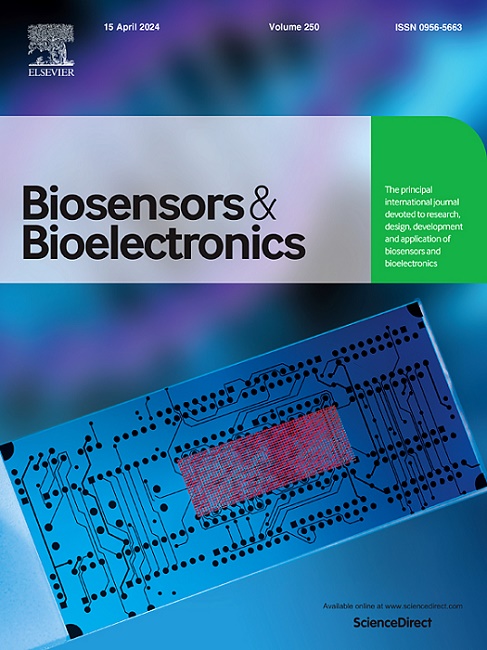基因工程整合黄曲霉毒素B1和脱氧雪腐菌醇双特异性纳米体作为替代抗原,构建时间分辨免疫测定双检测方法。
IF 10.7
1区 生物学
Q1 BIOPHYSICS
引用次数: 0
摘要
存在真菌毒素联合污染的现象,其中黄曲霉毒素B1 (AFB1)毒性最大,脱氧雪腐镰刀菌醇(DON)污染较为常见。使用抗原进行真菌毒素的双重或多次检测容易造成环境污染,因此替代抗原已成为必要。纳米体的小分子特性和对基因修饰的敏感性可用于开发真菌毒素的替代抗原。本研究利用抗黄曲霉毒素和脱氧雪腐镰刀菌醇单克隆抗体重链识别区的纳米体基因序列,通过一步克隆成功构建了重组质粒,获得了低温诱导的抗AFB1-DON双特异性纳米体,可作为替代抗原,减少霉菌毒素检测对环境的污染。酶联免疫吸附实验验证了该纳米体对AFB1和DON的半抑制浓度(IC50)分别为0.47 μg/L和149 μg/L。最后,利用该双特异性纳米体构建时间分辨荧光双检测试纸条,作为AFB1和DON的替代抗原,能够同时检测AFB1和DON,两种毒素的检出限(LOD)分别为0.0254 μg/L和21.4 μg/L。该方法具有令人满意的灵敏度,且不需要抗原,降低了使用抗原的毒性。本文章由计算机程序翻译,如有差异,请以英文原文为准。
Genetically engineered integrated aflatoxin B1 and deoxynivalenol bispecific nanobody as surrogate antigens for constructed time-resolved immunoassay dual detection methods
There is a phenomenon of combined contamination of fungal toxins, of which aflatoxin B1 (AFB1) is the most toxic, and deoxynivalenol (DON) contamination is common. The use of antigens for double or multiple testing of mycotoxins is easy to cause environmental pollution, and surrogate antigens have become necessary. The small molecule and susceptibility to genetic modification of nanobodies can be used to develop alternative antigens for mycotoxins. In this study, using the nanobody gene sequences of the heavy chain recognition regions of anti-aflatoxin and deoxynivalenol monoclonal antibodies, recombinant plasmids were successfully constructed by one-step cloning, and low-temperature-induced bispecific nanobodies against AFB1-DON were obtained, which can be used as alternative antigens to reduce the pollution of the environment from mycotoxin detection. Enzyme-linked immunosorbent assay validated the bispecific nanobody, and the semi-inhibitory concentration (IC50) of the bispecific nanobody were 0.47 μg/L and 149 μg/L for AFB1 and DON, respectively. Finally, a time-resolved fluorescent dual-detection test strip was constructed by this bispecific nanobody as a surrogate antigen for AFB1 and DON, which was capable of detecting AFB1 and DON at the same time, and the limits of detection (LOD) for the two toxins were 0.0254 μg/L and 21.4 μg/L, respectively. This method has satisfactory sensitivity and does not require antigen, which reduces the toxicity of using antigen.
求助全文
通过发布文献求助,成功后即可免费获取论文全文。
去求助
来源期刊

Biosensors and Bioelectronics
工程技术-电化学
CiteScore
20.80
自引率
7.10%
发文量
1006
审稿时长
29 days
期刊介绍:
Biosensors & Bioelectronics, along with its open access companion journal Biosensors & Bioelectronics: X, is the leading international publication in the field of biosensors and bioelectronics. It covers research, design, development, and application of biosensors, which are analytical devices incorporating biological materials with physicochemical transducers. These devices, including sensors, DNA chips, electronic noses, and lab-on-a-chip, produce digital signals proportional to specific analytes. Examples include immunosensors and enzyme-based biosensors, applied in various fields such as medicine, environmental monitoring, and food industry. The journal also focuses on molecular and supramolecular structures for enhancing device performance.
 求助内容:
求助内容: 应助结果提醒方式:
应助结果提醒方式:


